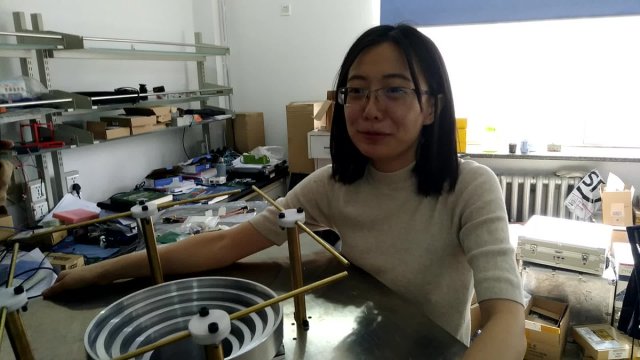
Hu Chaoran BG2CRY tests 435/2250 MHz dish feed for DSLWP ground station – Image credit Wei Mingchuan BG2BHC
DSLWP is a lunar formation flying mission led by Harbin Institute of Technology for low frequency radio astronomy, amateur radio and education. It consists of a pair of 47 kg microsatellites launched from the Xichang Space Center into a lunar transfer orbit at 21:28 GMT on Sunday, May 20, 2018 and they will enter a 300 x 9000km lunar elliptical orbit. Onboard each satellite, there are two VHF/UHF SDR transceivers to provide beacon, telemetry, telecommand, digital image downlink and a GMSK-JT4 repeater. Onboard transmitting power is about 2 watts.
Update May 21, 2018: After deployment signals from the DSLWP satellites were received by Edson Pereira PY2SDR, Nicolás Castro CD3NDC, Robert Mattaliano N6RFM and many other radio amateurs around the world.

Chen Yue with 435/2250 MHz feed for the 12m dish at the DSLWP ground station – Image credit Wei Mingchuan BG2BHC
Wei Mingchuan BG2BHC reports the first launch window will open at about 21:28 GMT Sunday, May 20. The transmitters will be activated soon after separation. Satellite A will transmit 500 baud GMSK with 1/4 turbo code on 435.425 MHz and 250 baud GMSK with 1/2 turbo code and precoder on 436.425 MHz, and satellite B will transmit 500 baud GMSK with 1/4 turbo code on 435.400 MHz and 250 baud GMSK with 1/2 turbo code and precoder on 436.400 MHz, in every 5 minutes by default. Each transmission will last about 16 seconds. Radio amateurs in South America will have the earliest chance to receive the signals from the satellites, then North America, Oceania, Asia, Europe and Africa.
Harbin Institute of Technology Amateur Radio Club expects radio amateurs to join in this mission. We will prepare different QSL cards for different flight phase for amateurs successfully made QSO or received telemetry. Awards will also be given to the first 10 amateurs in each continent who successfully decoded the signals from the satellites, received the most number of packets, or received an image. Your participation will also help the team to get a better knowledge of the status of the satellites.
An open source decoding software based on GNU Radio to work with RTL-SDR and USRP is provided. Not difficult to change the grc files to support other SDR receivers. A small proxy software will send the decoded data to a server for real-time display.
IARU frequency coordination page:
http://www.amsatuk.me.uk/iaru/finished_detail.php?serialnum=530
Link budgets: http://lilacsat.hit.edu.cn/wp/?page_id=676
Decoder (GNU Radio OOT module): https://github.com/bg2bhc/gr-dslwp
Decoder (Linux Live CD): https://1drv.ms/u/s!Av6J6WjI3UbMhHm8gwMr4Z_keqWH
TLE: http://lilacsat.hit.edu.cn/tle/dslwp.txt
DSLWP-A Telemetry Display: http://lilacsat.hit.edu.cn/dashboard/pages_en/telemetry-a.html
DSLWP-B Telemetry Display: http://lilacsat.hit.edu.cn/dashboard/pages_en/telemetry-b.html
Wei Mingchuan BG2BHC Bug Fix 2018-05-20-1728-GMT: (Check BG2BHC Twitter feed for any further updates)
Sorry to find a bug in the DSLWP live cd! This bug will make the upload of data fail, so it is important to fix it. Please close the proxy, open a new terminal, and type in the following commands:
sudo python -m pip uninstall tornado
sudo python -m pip install tornado==4.5.3
The password is lilac
After running these commands, the bug should be fixed.

DSLWP Lunar Satellite




You must be logged in to post a comment.